Enterprise SATA SSDs: Can Budget 2020 beat Top Line 2017?
by Billy Tallis on February 4, 2020 11:00 AM ESTQD1 Random Read Performance
Drive throughput with a queue depth of one is usually not advertised, but almost every latency or consistency metric reported on a spec sheet is measured at QD1 and usually for 4kB transfers. When the drive only has one command to work on at a time, there's nothing to get in the way of it offering its best-case access latency. Performance at such light loads is absolutely not what most of these drives are made for, but they have to make it through the easy tests before we move on to the more realistic challenges.
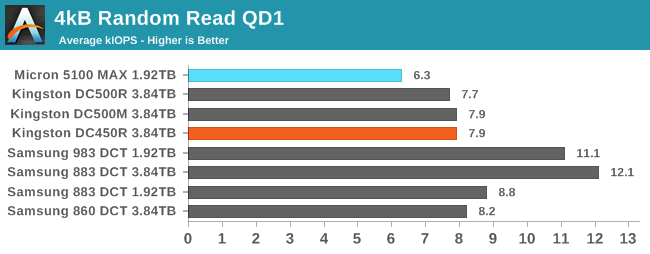
The Micron 5100 MAX has about 20% worse QD1 random read performance than the Kingston drives. This is primarily due to the underlying NAND: the 5100 MAX uses first-generation Intel/Micron 3D TLC, which was consistently slower than their newer 64L 3D NAND. But even the 64L Intel NAND used by Kingston's drives is still slower than Samsung's drives.
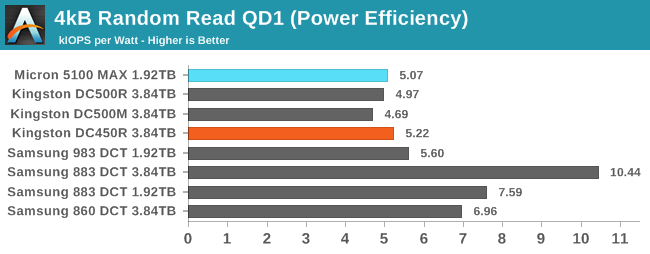 |
|||||||||
| Power Efficiency in kIOPS/W | Average Power in W | ||||||||
The Kingston DC450R uses a bit less power than the other two Kingston drives and thus ends up with the best efficiency rating among the three, but they're all considerably more power-hungry than the Samsung SATA drives. The Micron 5100 MAX uses only slightly more power than the Samsung SATA drives, but its lower performance leaves it with a similar efficiency score to the Kingston drives.
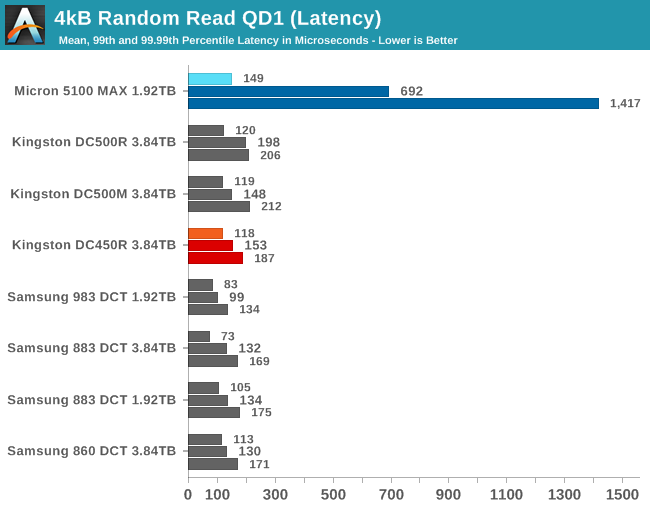
The Micron 5100 MAX stands out from the newer drives for having much worse tail latency scores, despite being a very high-end model. It's occasionally taking well over a millisecond to return data, which is surprisingly poor QoS for such a light workload. The Kingston DC450R fares similarly to the DC500s, with tail latencies that are only slightly higher than the average latency.
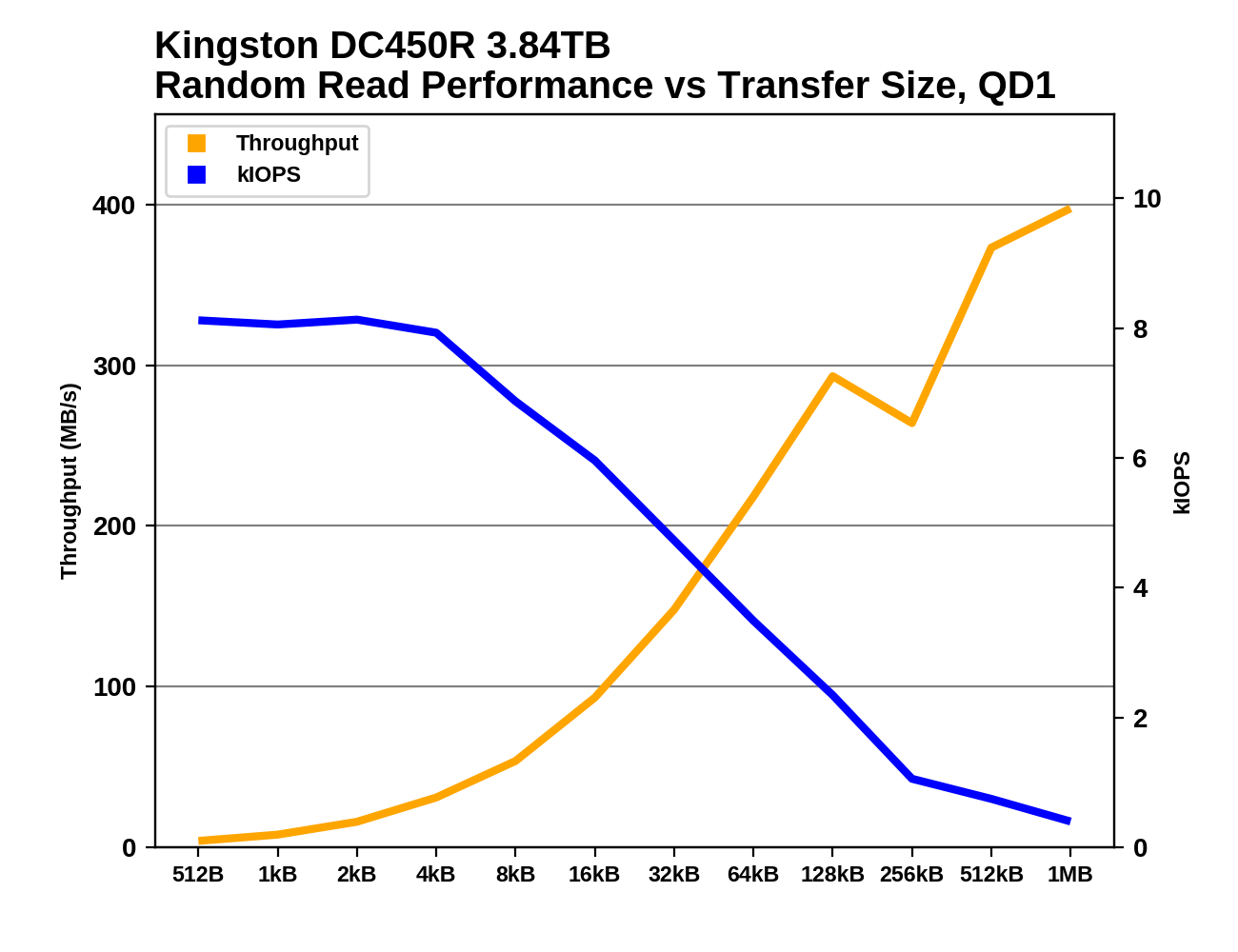 |
|||||||||
The Kingston DC450R and Micron 5100 MAX both show roughly constant IOPS for random reads up to 4kB in size, in line with the other Kingston drives rather than showing the peak at 4kB that the Samsung 883 gives. Beyond 128kB, the DC450R shows a more severe faltering in performance than most of the other SATA drives, while the Micron 5100 MAX simply shows performance that grows relatively slowly with transfer size.
QD1 Random Write Performance
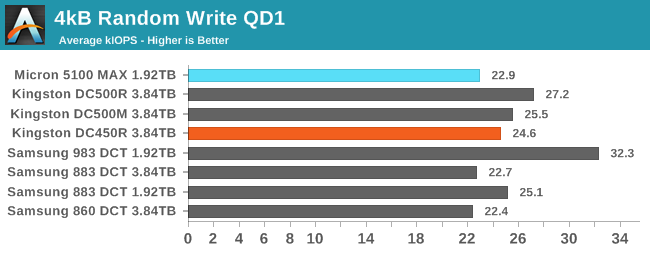
There's not much variation between the SATA drives for QD1 random write performance. All of these drives are capable of accepting a write command into their cache fairly quickly, and fully disguise the latency of actually writing to the flash.
 |
|||||||||
| Power Efficiency in kIOPS/W | Average Power in W | ||||||||
The Kingston DC450R's power draw during the QD1 random write test is quite high, second only to the DR500R—these drives are clearly busier in the background than the DC500M that has more spare area to work with. Those two drives end up with the worst efficiency scores by far for this test. The Micron 5100 MAX averages only 2W compared to over 5.5W, so it has a great efficiency score here.
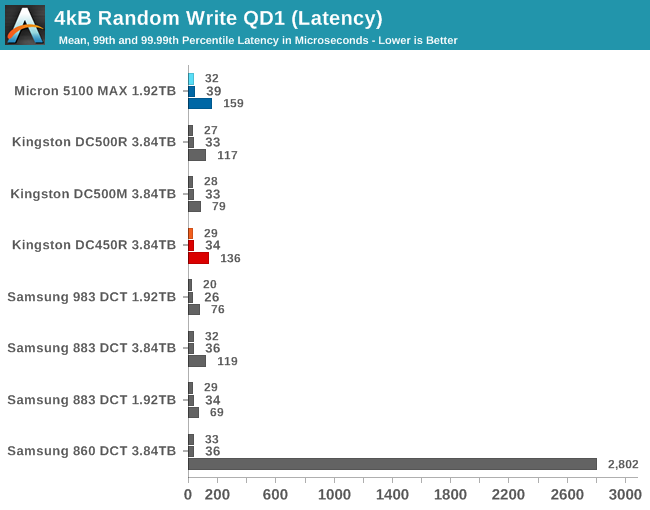
The Micron 5100 MAX and Kingston DC450R both have fairly typical latency scores for this test. Neither suffers from the stand-out tail latency problem the entry-level Samsung 860 DCT has.
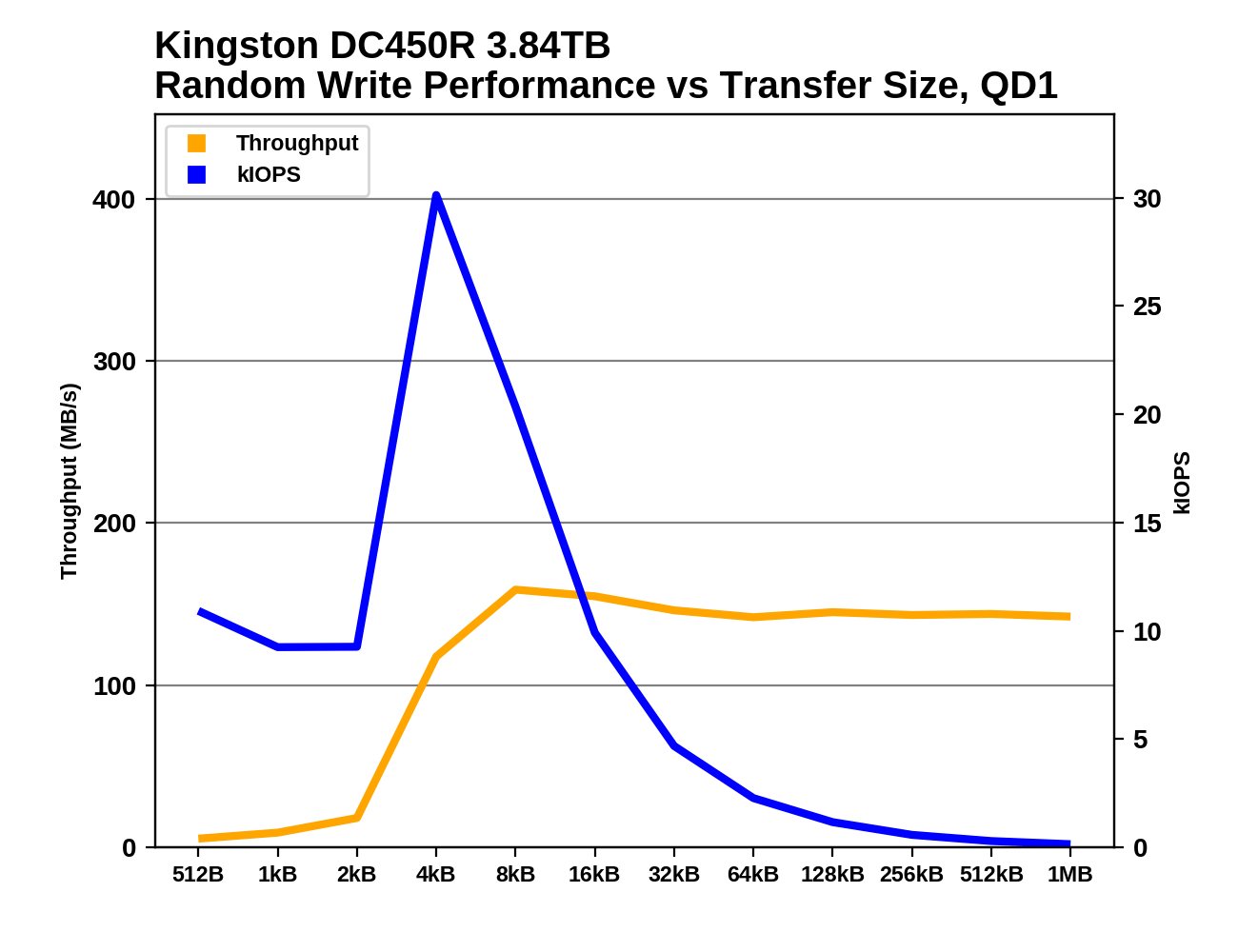 |
|||||||||
The Kingston DC450R didn't wasn't narrowly tuned for 4kB operations when it came to random reads, but for random writes it's definitely optimized for that one specific block size, and to a greater degree than the DC500R. The Micron drive also gives peak random write IOPS for 4kB block sizes, but handles everything from 512 bytes up to 8kB fairly well.
QD1 Sequential Read Performance
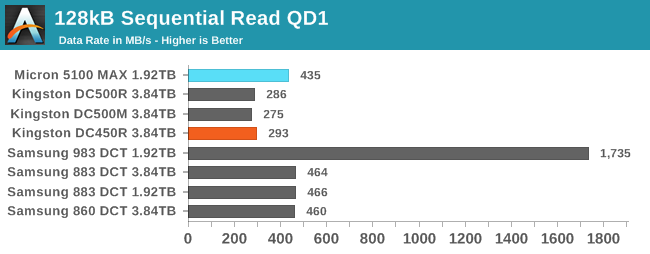
The Kingston DC450R continues the pattern set by the DC500 series of fairly low sequential read performance at QD1. The Micron 5100 MAX is only a bit slower than the Samsung drives on this test.
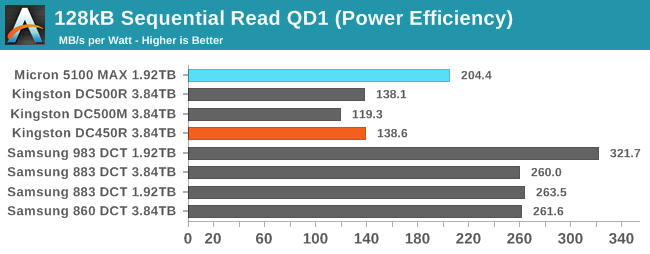 |
|||||||||
| Power Efficiency in MB/s/W | Average Power in W | ||||||||
The Kingston DC450R and Micron 5100 MAX both use about the same amount of power on this test, about 20% more than the Samsung drives. That leaves the Kingston drive with barely more than half the performance per Watt of Samsung's SATA drives, while the Micron has about three-quarters.
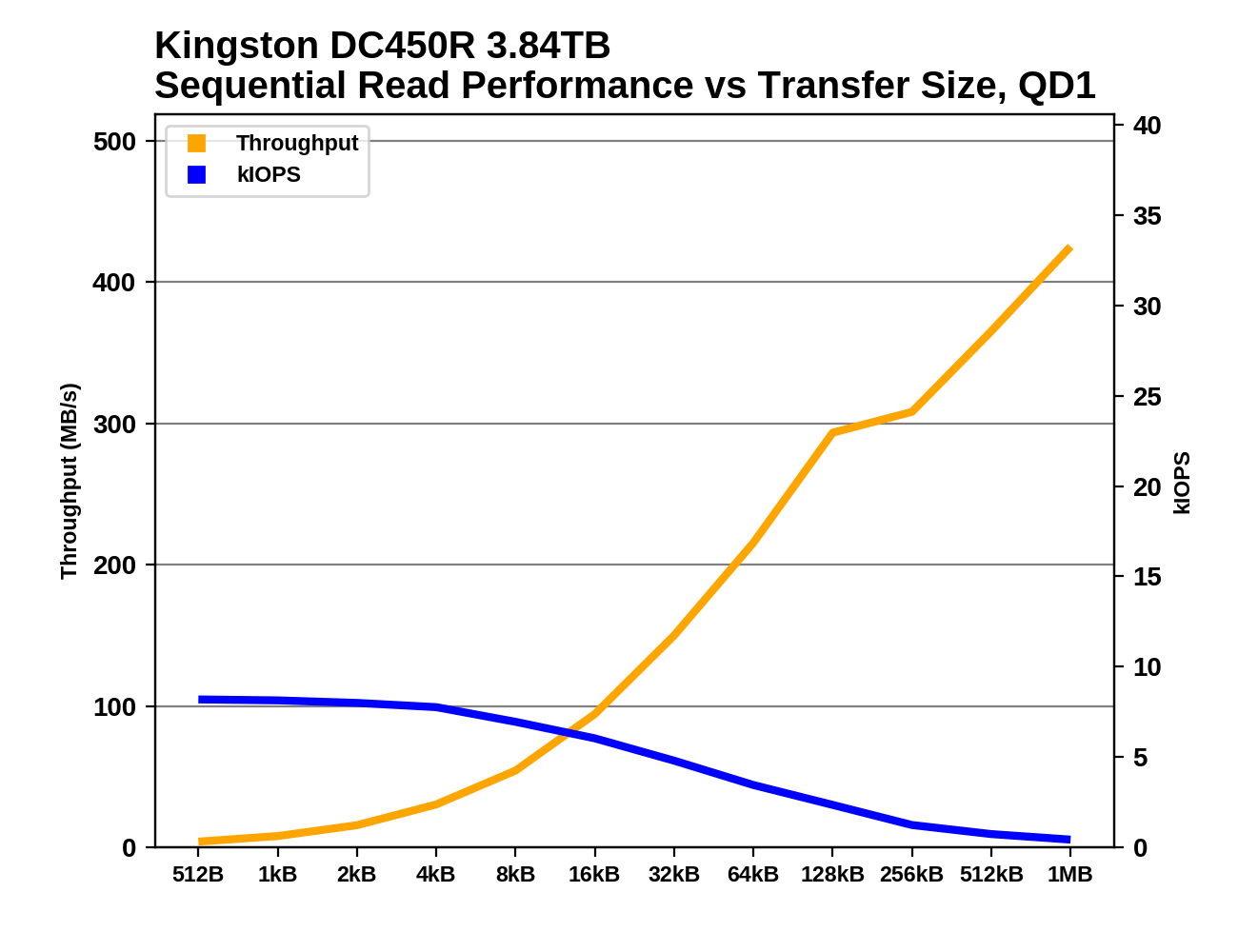 |
|||||||||
The Micron 5100 MAX provides full sequential read speed with block sizes of 128kB or larger, similar to the Samsung drives. The Kingston DC450R inherits the same behavior as the DC500 series, with sequential read performance that is still catching up as the block size grows up to a full 1MB.
QD1 Sequential Write Performance
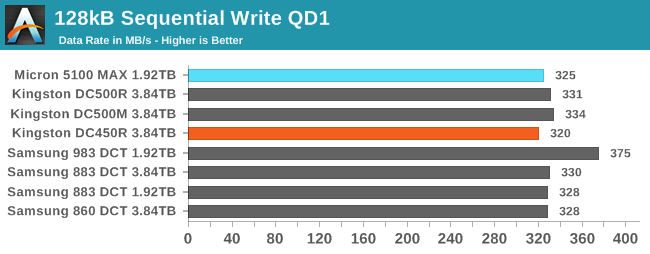
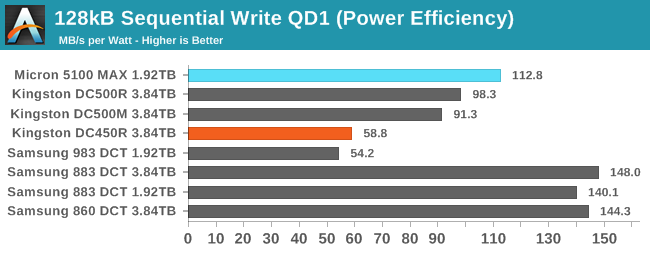 |
|||||||||
| Power Efficiency in MB/s/W | Average Power in W | ||||||||
These SATA drives all have about the same QD1 sequential write performance. The important differences show up when we look at the power meter. The Kingston DC450R is far and away the most power-hungry of the SATA drives, giving it a much worse efficiency score than even the DC500s. The Micron 5100 MAX offers almost twice the performance per Watt on this test, but the Samsung SATA drives still clearly lead the pack for efficiency.
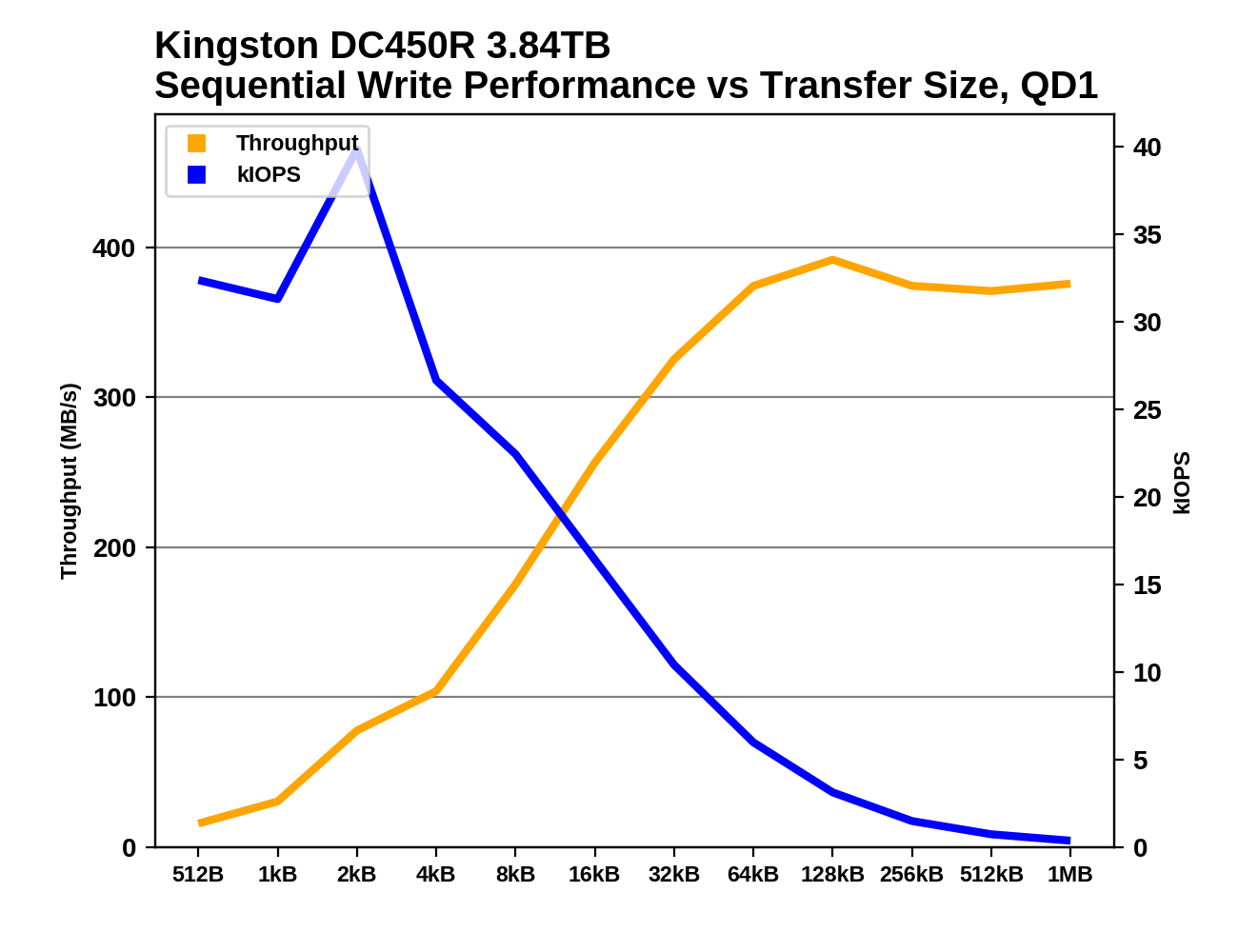 |
|||||||||
The Micron 5100 MAX shows remarkably poor sequential write performance for block sizes smaller than 4kB, but there's not much real-world relevance to that weakness. At larger block sizes of 128kB and up, all of these SATA drives are able to get reasonably close to the limits of their host interface—though the Kingston DC450R is still a little bit slower than the others.










20 Comments
View All Comments
FunBunny2 - Wednesday, February 5, 2020 - link
"So, even a "serious" database running on any reliable disk (ie: one not lying about flushes) will be 100% functional/safe; however, performance will tank."industrial strength RDBMS still offer (on *nix OSs, at least) raw devices, which means the database engine does all the I/O, and always (IIRC) runs with more integrity guarantees and efficiency. it's just that *nix OSs have gotten sufficiently better at both over the last couple of decades that most RDMBS app developers discourage their clients from configuring that way.
FunBunny2 - Wednesday, February 5, 2020 - link
"There is a difference between data integrity and persistency, but power-loss protection is needed for either."depends on what the definition of 'it' is. way back in the late 80s and early 90s, SQL databases ran on machines without UPS or other forms power persistence. what industrial strength RDBMS did guarantee is that a use session would lose only its last in-memory transaction. app developers took this into account when designing transactions. they still have to, since any number of failure modes exist beyond just pulling the plug. RDBMS did, and still do, only guarantee integrity of data written to the write-ahead-log, which is where in-memory data is flushed on transaction completion. widespread use of storage class memory, and OS support for same beyond simulating a filesystems (gad!), will change this protocol. won't be next week.
Siddhartha - Wednesday, February 5, 2020 - link
Is there something I can do to stop your endless loop video popups? I understand you earn your living with advertising but the popups actually block your content. I usually spend a couple minutes on website and go somewhere because of the popups.RealBeast - Wednesday, February 5, 2020 - link
What video popups? cough, MVPS host file blocking, coughleexgx - Wednesday, February 5, 2020 - link
I exclusively use edge mobile browser on this website (the forums are even worse a floating video that follows you when you move up and down blocking over 70% of the page) 3 other sites that I use it on as well as they launch full screen ad when you click on a link for the first time or i page ads are floating with the page or randomly opening other pages when you try to swipe down (it thinks your tapping the add when your trying to pull down)Supercell99 - Wednesday, February 5, 2020 - link
Nothing about the Kingston drives are "Enterprise" . The DWPD are nothing special. The lack of power loss protection capacitors is a deal breaker. I don't care if it is read heavy. Enterprise means, critical data and business use with $$$$ at stake. Loss of data and downtime is very expense. No power caps and <1 DWPD makes this just another SATA SSD, "Enterprise" is some label they threw on to make some extra cash from suckers.Foeketijn - Saturday, February 8, 2020 - link
I bought a samsung 983 for 200 something euro's.Nice to install Windows server in about 2 minutes (and then need about 10 to go thought the bloatware options).
dromoxen - Wednesday, February 12, 2020 - link
Its a shame they couldnt do a quick re-write of the firmware , nobody? needs 42% over provisioning. Maybe take it down to 5,10.. that can be changed on installation. Voila , a shedload of extra capacity, which I would presume is the second selling point , after simply being a SATA ssd.